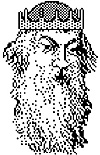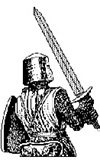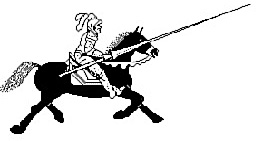 How often have you heard (or made) the remark, -- "The book was much better than the movie." Why does that almost always seem to be the case? Could it perhaps be that the amazing technology of the wide-screen, Dolby stereo and computerized special-effects can not match what a good page of words is able to create in our own mind and imagination. -- So I hear you asking, -- What does this have to do with fantasy role playing games?
How often have you heard (or made) the remark, -- "The book was much better than the movie." Why does that almost always seem to be the case? Could it perhaps be that the amazing technology of the wide-screen, Dolby stereo and computerized special-effects can not match what a good page of words is able to create in our own mind and imagination. -- So I hear you asking, -- What does this have to do with fantasy role playing games?
Everything really.
With all due respect to TSR Games, I will use the term D&D to mean Dungeons & Dragons, both the original and Advanced series. My introduction to D&D came in 1979 when a friend returned from vacation and gave me an hour long description of a new game he had come across. He was very excited about this D&D business and went on and on about the general concept, rules, strategy, tactics and endless subjects. In the end, I said "You've got to be kidding... that game is so bloody complicated nobody could play it!" Obviously I was wrong.
The game Dungeons & Dragons was invented by Gary Gygax ( and a host of co-developers) in the mid 1970's. The basic idea is simple and straightforward: interactive adventure with hazards, rewards, frustrations and a huge helping of humor. All of this is set in a medieval style of world with knights, wizards and clerics using swords, battle axes, chain mail armor, powerful spells, potions and assorted magical weapons. The adventures or campaigns may be played in open country, forest, mountains, caves, crumbling ancient castles and, of course, underground dungeons. Certainly no adventure would be complete without bad-guys and monsters -- D&D has more of these than you can count.
The key individual to any D&D group is, without a doubt, the Dungeon Master or "DM." This one person must have the talent (and experience) to function as a referee, coach, conductor and judge advocate. An old saying goes, "There are two basic rules in Dungeons & Dragons: (1) NEVER argue with your Dungeon Master and (2) ALWAYS observe rule number one."
A D&D group will consist of a DM and several players. While there is no official limit on the number of players, there are practical considerations such as the size of your dining room table or wherever you play. Each player will have a character and experienced players may wish to have more than one character. The individual characters (with colorful names such as Kheldar of Boktor or Grundfoss and his faithful war-pig Oscar) are created or "generated" by means of a rather structured set of rules and random numbers (i.e. dice).
These characters will be categorized as: Human, Half-Orc, Halfling, Half-Elven, Gnome, Elven or Dwarven. The racial stock of the character sets certain "class" limitations. For example: a Dwarf may not be a magic-user and only a Human may be a Monk. When a character is created, dice are rolled to determine the character abilities. These would include such things as: strength, intelligence, wisdom, dexterity and constitution. A high degree of strength, but low intelligence may be just right for a fighter, whereas high intelligence and wisdom would better suit a cleric or magic user. There are some options which do not require a roll of dice, but are left to the choice of the player.
Alignment is one such option: a character may range from Lawful Good to Chaotic Evil and within each alignment there are rules on behavior. Like an actor on stage, the player must play his character properly; even to the extent that although you (the player) may know something, that doesn't mean your character knows it. Occasionally, during a game, a player may say something to me and I have to ask -- "Are you speaking as Once the process of determining the vital statistics has been completed, the player (usually helped by the DM) will scrutinize these figures, consult the Players Handbook and decide the vocation (class) of the fledgling character. Another roll of dice will
determine how much money our new character will be given to start his (or her) new career. This is important, as there is little point in sending forth an adventurer without some basic equipment -- such as weapons, armor, clothing and general provisions.
By this time, the new character probably has a name and a physical description will be recorded on his Character Record sheet. D&D is a game of records and keeping statistics. The character may begin life on a single sheet of paper, but before long that will develop into a folder and that into a binder.
Random Numbers
Almost everything in D&D is determined by random numbers. Sometimes this is a simple roll of one six-sided die or the situation may require a number to be weighted (by experience or special weapon or whatever) and would call for two four-sided dice plus a fixed number. Dice used in D&D range from four-sided to twenty-sided. Therein lies the element of chance: a very
experienced fighter may be attacking a most humble monster, but if he rolls a 1 to hit, he drops his sword on the ground with a great CLANK. (Much laughter heard around the table.)
The D&D adventure or campaign may be homemade (by the DM) or from a commercially produced module. In either case, the players assemble around a suitable table with their characters still residing in paper folders. Some sort of mapping device is required and may be simply a supply of graph paper or a clear plastic sheet with a grid paper attached on the underside. Different
scales and styles of grids may be used according to where your party is playing.
A typical party, consisting of: two fighters, a thief, a cleric and a magic user, will enter a dark, dank dungeon far below an ancient castle keep. Flickering yellow light from an oil-soaked torch illuminates about thirty feet of rough stone passageway ahead. Water drips from the ceiling and falls into green, slimy pools that soak your leather boots. The air in this dungeon is stale and it seems likely that no living thing has been in here for ages. Suddenly, from the inky black shadows... (and all around the table, five sensible grown men, in chorus, yell "AHHHhhhh!!!") ...jumps a huge sewer rat. Two chain mail clad fighters will, at this point, half kill themselves trying to strike the terrified rat with their huge swords in this confined passageway, the cleric is praying for a
Bless Spell, the magic-user is threatening to cast a fireball and the thief... say, where is that thief anyway? All of this has been created by a few well chosen words from the DM. You are hooked and the adventure has begun.
It is important to understand that no one individual actually controls a D&D game -- not even the Dungeon Master. Although the DM exerts considerable influence and the players may exercise careful skill with their characters, there are just too many variable factors for the conclusion of anything to be set. Recently my character (Grundfoss) was nearly wiped out by our Wizard firing a wand in a confined hallway. A powerful lightning bolt ricocheted off of every wall in sight.
Most D&D players seem to enjoy a bit of good old fashioned "hack 'n slash" combat. The weapons are strictly medieval: two-handed swords, crossbows, halberds and other such simple but lethal devices. Magical weapons are both fun and essential as certain types of monsters can not be "hit" by conventional devices. Some characters will, by virtue of their strengths and abilities, be
awarded a proficiency with one particular weapon or type of weapon. This gives a greater chance to hit and increases the damage when striking an opponent. There are monsters who fight downright dirty and you need all the help you can get. Hey, nobody said it would be easy down here in the dungeon!
Sooner or later (probably sooner) the party will encounter someone or something which is less than sympathetic to your cause. First, the DM will call for an "initiative" check. This is accomplished by rolling two six-sided dice -- one for the party and one for the unfriendly. The high roll will determine who goes first in combat. In a tense situation, some characters will be prone to draw
weapons and charge right in swinging, but there is little harm in first trying to establish communications.
In the world of D&D many languages exist and it could be that someone in your party is able to speak with the monster. You
may find that the unfriendly posture is the result of fear or territorialism and you are able to talk your way past an unpleasant situation. On the other hand, this monster may be just downright mean; in which case -- Cry "Havoc!"
Melee
It wasn't long after the advent of home computers that role playing game programs appeared. At first, these were presented as "text adventures" and many were in the style of D&D. The INFOCOMŽ company produced quite a few excellent games (e.g.. Enchanter, Sorcerer and Zork) which are still available for PC, Mac and Amiga. With the stunning animated graphics and stereo sound capability of modern computers, you might think that a group of people sitting around a table playing D&D with bits of paper and dice would be obsolete.
It isn't. I have several D&D computer games and yes, they can be very entertaining and challenging. However, it just isn't quite the same as having the inputs of real live players and a good Dungeon Master. Computers fail to produce the effects of laughter, shouting, the clatter of dice on the table and "Do we have any more popcorn?" Over the years, Dungeons & Dragons has drawn criticism and even condemnation from certain misinformed -- and generally religious-minded -- individuals because of the references to wizards, magic, spells, deities and demons.
Give me a break! D&D is a fantasy role playing game -- nothing more. Unfortunately, there are some people in our society who have great difficulty in distinguishing between fantasy and reality. These persons would be well advised to avoid D&D, books by Stephen King and most R-rated Hollywood movies.
The basic requirements for a Dungeons & Dragons player are: a vivid imagination and a good sense of humor. If you meet these criteria, but have never experienced the game, perhaps you should ask around -- you may be surprised to discover some
ardent D&D players among your friends or colleagues.
For further information you may wish to read the Official Advanced Dungeons & Dragons Players Handbook by Gary Gygax. Published by TSR Inc.
NOTE: Dungeons & Dragons, Advanced Dungeons & Dragons, D&D and AD&D are Trademarks of TSR Games Inc.
 The Dungeon Master usually begins by telling the party a story which sets the scenario of the adventure. To the north of the White Mountains, in what was a once a peaceful valley, lie the ruins of... and off you go. The DM will tell only what you need to know and what your character is entitled to know at that point. Nothing more. Perhaps this is where D&D differs greatly from board games. The Dungeon Master paints word pictures and although mapping is important -- even crucial at times -- the game is played in your mind.
The Dungeon Master usually begins by telling the party a story which sets the scenario of the adventure. To the north of the White Mountains, in what was a once a peaceful valley, lie the ruins of... and off you go. The DM will tell only what you need to know and what your character is entitled to know at that point. Nothing more. Perhaps this is where D&D differs greatly from board games. The Dungeon Master paints word pictures and although mapping is important -- even crucial at times -- the game is played in your mind.
 The participants in a melee combat situation have a number of options: attack, parry, fall back or flee. Obviously, each type of weapon has a different damage potential. A two-handed sword is able to hit much harder than a wooden club, but there may not be room to swing a large, heavy weapon. Every character and every monster has an Armor Class (AC) and likewise, they have Hit Points (HP). The rules of combat take all of these factors (and more) into account to produce a fairly realistic melee. Any attempt to explain the exact procedure in this article would result in several paragraphs of utterly confusing text -- but the truth
is, combat is really straightforward and moves at a good pace.
The participants in a melee combat situation have a number of options: attack, parry, fall back or flee. Obviously, each type of weapon has a different damage potential. A two-handed sword is able to hit much harder than a wooden club, but there may not be room to swing a large, heavy weapon. Every character and every monster has an Armor Class (AC) and likewise, they have Hit Points (HP). The rules of combat take all of these factors (and more) into account to produce a fairly realistic melee. Any attempt to explain the exact procedure in this article would result in several paragraphs of utterly confusing text -- but the truth
is, combat is really straightforward and moves at a good pace.
Back to Cry Havoc #4 Table of Contents
Back to Cry Havoc List of Issues
Back to MagWeb Master Magazine List
© Copyright 1993 by David W. Tschanz.
This article appears in MagWeb (Magazine Web) on the Internet World Wide Web. Other military history articles and gaming articles are available at http://www.magweb.com